Preili Museum of History and Applied Arts (Latvia), Grodno State Museum of the History of Religion (Belarus) and Panevezys Local Lore Museum (Lithuania) joint virtual exhibition – traditional woodwork.
Preili Museum of History and Applied Arts
Dowry chest. The end of 19th century – beginning of 20th century
At the end of the 19th century – the beginning of the 20th century, typical furniture for storing various objects and clothes in Latgale, was a dowry chest or skreine. In Latgale, such dowry chests were usually painted in green or blue, decorating them with a variegated stamps creating a floral theme. In addition, the dowry chests were supplemented with thin, smooth black-painted metal strips, especially treating chests body, corners and cover. Presumably in this way, the chest was given additional stability, making it more transport-friendly, because not only did the daughters of Latgale farmers have to move to nearby villages after marriage, often the whole family had to take the wheels, in search of higher profits.
Wooden bucket. The end of 19th century – beginning of 20th century
Until the middle of the 20th century, wood was by far the most common material in the household of a Latgale farmer. It was widely available, easily replaceable and very adaptable when making something new. Also, there was no shortage of craftsmen, as woodworking skills were passed down from father to son for many generations. Not only household furniture was made of wood, but also everyday objects, such as wooden buckets. To make them, each household had templates for specific bucket size. At the beginning, the wood was processed by cutting out wooden planks of the required size and shape, then they were adjusted to each other, the bottom of the bucket was fixed and the body was tightened with a wooden hoop. As the wood got wet, buckets of this type could safely be used to carry and store a wide variety of liquids. In the middle of 20th century, bucket of the museum’s collection, was tightened with metal wire, replacing original wooden hoops and handle to further use.
Decorative window elements. The first half of the 20th century.
Until the first half of the 20th century, when electricity was rare thing in many country houses, the window was the main light source in the room. Therefore, the windows of the houses were specially decorated, pointing out their great value in the daily rhythm of the farmers life, when all the works were started and finished in the daylight. Decorative window elements were made by wood craftsmen, here in the Preili side, they were craftsmen from local Old Believers’ villages who visited the houses with whom in the previous summer were made an agreement or offered their craft skills for work in the following year. The decorative window elements were made up from 3 parts – the upper part (window crown, profiled cornice and front board), the middle part with side boards and the window sill in the bottom of the window. Various geometric ornaments and natural motives were used in the production of those elements – birds, stars, plant windings, etc. The wealthiest household also installed decorated window shutters, symbolically closing them after sunset, further emphasizing the great connection of man with the rhythms of nature.
Hrodna State Museum of the History of Religion
The museum collection “Wood” of the Grodno State Museum of the History of Religion numbers more than 650 items. It has its origin in 1974 It includes sculptures of the 16th-20th centuries (Catholic saints, angels, crucifixes), decorative carvings from the interiors of Catholic and Orthodox churches, small sculptures (animals, mythical creatures, fairy-tale characters), ethnographic and household items (baking dishes for Easter cakes, kitchen utensils, spoons, storage chests, spinning wheels, shuttles, spindles, furniture, decorative works, etc.), which have not only a utilitarian, but also a ritual purpose and are necessary for displaying the calendar and family rituals of Belarusians. The collection also includes sculptures of Eastern religions.
The most valuable museum items in the museum collection are the monuments of the Catholic Church. In Belarus, it was typically made of wood. Wood is not a very durable material,therefore every item that has not been affected by time, war and fire and which has survived to our time is the greatest value for the art of Belarus, a role model for modern masters.
Saint Casimir. Belarus. 1630s. Wood carving.
The saint is presented full-height, in a loose fur coat and an ermine pelerine. On his neck, there is a massive chain with an oval medallion. On his head, there is a princely crown.
The early baroque style was reflected in the smooth line of the figure’s silhouette, static posture, and realistic facial expression with individualized features. Harmony and rhythm are seen in the delicately draped folds of clothing, semicircular outlines of the pelerine, chain and collar. The item comes from a church in the village of Kvasovka, Grodno District, known since 1626. Stylistic features, topographic origin, and the development of the saint’s cult determine the dating to the 1630s.
Saint Casimir (1458 – 1484) is the heavenly patron saint of the Grand Duchy of Lithuania, the son of the King of Poland and the Grand Duke of Lithuania Casimir Jagiellonchik. He died in Grodno and was buried in the Vilnya Cathedral. The cult of the prince began to develop immediately after his death, but especially quickly after the canonization in 1602. Images of St. Casimir in churches could be often found side by side with images of St. Stanislav, who was considered the patron saint of the Kingdom of Poland.
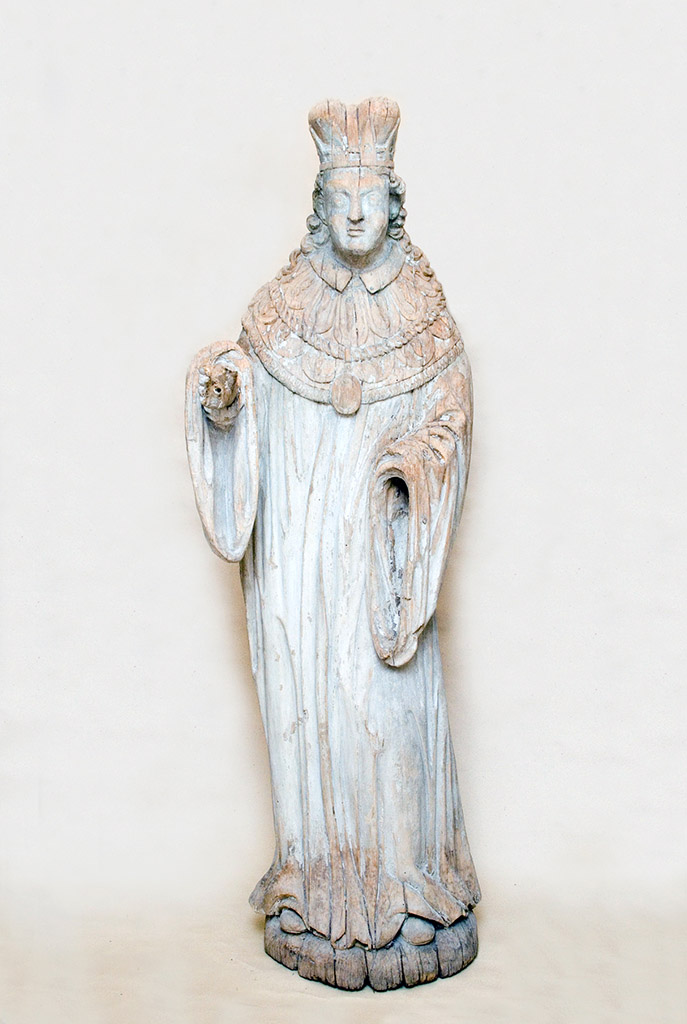
Sculpture. Angel with a trumpet. Belarus. 18th century. Wood. Levkas, polyment, carving, gilding, polychrome painting.
The angel is shown full-height, in a long caftan. The right leg bent at the knees is put slightly forward. There is a trumpet in his left hand; there are spread wings with a relief modeled plumage behind his back.
The desire to recapture the movement, balance combined with some decorativeness, the interpretation of the belt effectively tied with a bow, the common people prototype, and the formal rendering of the anatomy of the body are characteristic features of the “local” baroque style of the 17th century this sculpture belongs to.
Angels with musical instruments reflected ideas about the divine origin of music and its main purpose to glorify the Creator.
Crucifixion. Belarus. XVIth century. Wood. Carving, polychrome.
Crucifixion is the earliest plastic art image in the interior of a Christian church. In medieval temples, it was usually located at the top in front of the presbytery or at the main altar, as well as at the entrance.
A wooden polychrome crucifix was kept for a long time in the funds of the Grodno State Museum of the History of Religion. It was supposedly dated back to the 19th century. In connection with the preparation of a new museum exposition, in which the sculpture was to be presented, it was necessary to clarify the time of its production. During a special study, it turned out that the item might have an earlier origin. In this regard, the museum asked for help to Mrs. Maria Matushakaite (Kaunas, Lithuania). She is known for researching the art of wooden sculpture for many years on the territory of the former lands of the Grand Duchy of Lithuania.
The researcher drew attention to the style of the perizoma, which tightly fits the body of Christ. Its drapery with evenly folded straight folds on the sides is the main characteristic feature that allows the monument to be attributed to the 16th century. Only in the works of sculpture and painting of the Renaissance it was possible to find straight or almost straight folds of the perizoma, which form parallel groups rather densely enveloping the body. They are much shorter than the soft Gothic folds and do not rise like the Gothic folds of the so-called “broken style”.
As a result, the researcher came to the conclusion that the sculpture was made in the local tradition by a talented master who did not copy the works of famous sculptors, but used the local type.
Panevėžys Local Lore Museum
According to the author of the first History of Lithuania in the native language Simonas Daukantas, once upon a time, “the whole land looked like entire forest”. Trees, wood were used both as a raw material and as a main building material: until the middle of the 20th century, in the traditional Lithuanian village, all homestead buildings were wooden; most work tools, interior details, furniture, dishes, cutlery are also wooden; even household items, such as shoes, combs, suitcases, bags, etc., were made of wood. Various craftsmen worked with wood: carpenters, wheelwrights, spinning-wheel makers, umbrella crafters, clog crafters, cross crafters, tub crafters, furniture crafters and others. Craftsmen used whole tree for their craftwork: wood, bark, and roots. Traditional musical instruments, children’s toys and ceremonial Užgavėnės (Lithuanian festival that takes place during the seventh week before Easter, corresponds Mardi Gras) masks were also wooden. The tree is also given a sacral mythical meaning: wooden sacral monuments of small architecture, such as crosses, roof pillars, chapel pillars, were built in cemeteries, near homesteads, near roads or farmlands; small chapels and trees raised to mark special trees or events; the symbols of the tree of life were carved on women`s work tools, were painted on furniture, chests, were enwoven, embroidered, crocheted in traditional textile products. Thus, the tree is an integral part of everyday and sacred life of Lithuanians, accompanying her or him from birth to death – from cradle to coffin.
The Panevėžys Local Lore Museum has many traditional woodwork exhibits, the oldest of them dates to the end of the XVIIIth century. Traditional woodwork is divided into the following sets: 1) building structural parts, decor elements and building devices; 2) small architectural monuments: crosses, roof pillars, chapel pillars, chapels; 3) sacral wood sculpture; 4) household items and accessories; 5) Craftsmen work tools; 6) work tools for various businesses; 7) music instruments. We have selected the most valuable exhibits of small architectural monuments, sacral wood sculpture, musical instruments, and work tool exhibit-sets for presentation.
Vincas Svirskis crosses (end of the XIXth century) in an exhibition at the museum “Cross crafts in Panevėžys region“. Photo by G. Lukoševičius, 2005.
In Lithuania, people who created wooden crosses, roof pillars, chapel pillars, carved sculptures of saints called Cross crafters or god-maker, and this traditional art form is called – cross crafting. Due to its uniqueness and value, Lithuanian cross-crafting was included in the UNESCO List of Oral and Intangible Culture heritage of Humanity in 2001. Vincas Svirskis (1835–1916) was the most famous cross-crafter in the second half of the 19th century and the beginning of the 20th century in Panevėžys region. This Master of the Crosses, who graduated just from the parish primary school in the Tsar superiority period, has created over 200 folk baroque style crosses and pillar-type crosses made of oak, which decorated homesteads of farmers in Western Aukštaitija region and also were built in cemeteries. His crosses are unique by haut-reliefic carved sculptures of saints from solid oak. The sculptures are carved not only at the cross-joint (Crucifix) but also at several sides of pillar – there are crosses with sculptures on two, three or even four sides. The height of sculptures in the pillar of the cross is about 1 meter. V. Svirskis haut-reliefic sculpture style reminiscent of Baroque church sculpture: a plastic, round, soft shapes. The shape of the cross itself is also often associated with the architecture of Baroque churches: roofs, towers, wavy lines. The high mastery skill of the artist is proved by the fact that his works were created with primitive work tools: an axe, a chisel, a knife. The Panevėžys Local Lore Museum preserves three crosses created by V. Svirskis at the end of the XIXth century and one chapel column, which entered the museum from the Ramygala and Krekenava districts.

Four strings kanklės of the Aukštaitija region (Lithuanian stringed instrument) used to play Lithuanian multipart songs. Scooped wood, metal. Early XXth century. Photo by T. Stasevičius.
Like most nations, Lithuanian traditional folk instruments are made from wood. These are wind instruments: skudučiai (Pan pipes), daudytė (long wooden trumpet), horns, lumzdeliai (pipes), whistles; rhythmic: drums, tabalai, skrabalai, kleketai; the string musical instruments – kanklės. Panevežys region belong to ethnomusic area, where Lithuanian multipart songs were widespread: these are archaic polyphonic songs, performed solely on the principle of the female canon. There were contractual/ Lithuanian multipart songs were instrumental too: they were usually performed by men with skudučiai (Pan pipes), daudytė (long wooden trumpet), horns and kanklės. In 2010, Lithuanian multipart song, like cross-crafting, were included in the UNESCO List of Oral and Intangible Culture heritage of Humanity. Most wooden musical instruments were used by shepherds. The exception is kanklės. They were considered as a meditative instrument of the soul. Kanklės is an old string instrument of Baltic origin, also known as the Baltic fins (kanelės, kantelės) and in the lands of northwestern Russia (guslės).
It is a meditative, ceremonial instrument: it was believed that playing the kanklės could cure diseases, stave off disasters, and contact the world of the dead. Kanklės body is made of ash, maple, oak, black alder, deca – from spruce. According to the form of the instrument, there are three types of the instrument kanklės. The oldest are sculpted as boat or coffin shapes with 4 to 5 strings. With such kanklės in our country, men played Lithuanian multipart songs of two or four parts. The collection of The Panevėžys Local Lore Museum contains unique home-made wooden musical instruments: a drum which tightened with animal bones, a daudytė (long wooden trumpet) – wooden instrument, that can be found only in this region only in this region found and 4-string kanklės for playing Lithuanian multipart songs.
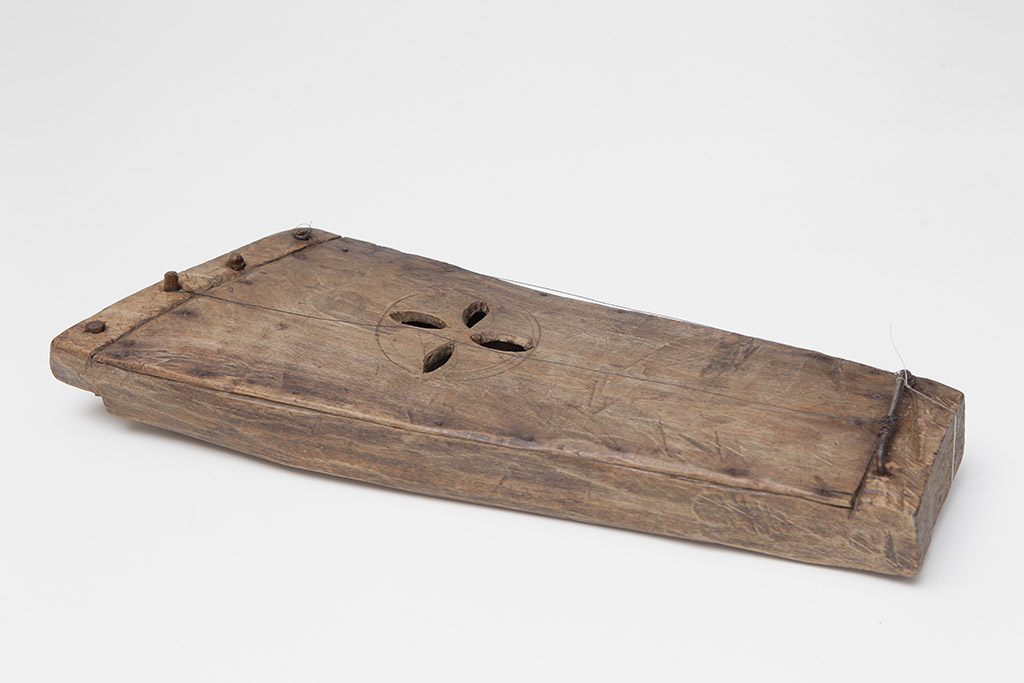
Distaffs. Wood, carving. The middle of the XIXth century and the end of the XIXth century. Photo by G. Kartanas.
Until the XIXth century, the old work tools of peasant’s were all wooden. Even for making heavy earthmoving tools, they used very little metal: wooden plough, harrow, shovel, and the forks were wooden. Women work tools, for the indoor works, were made with love and were given as a present, that’s why, they were so ornated and decorated with carvings. Spinning tools were usually a gift for women – distaffs and spindles, weaving tools –bobbins, shuttles, laundry beating and ironing tools – mangle, battledore. In Panevezys Museum is kept a valuable richly ornamented distaff collection of the middle of the XIXth century – and the end of XIXth century. With distaffs, women spined yarns before spinning wheels were used. In our country until the beginning of the XXth century, distaffs were usually in the shape of a lancet shape willow leaf or truncated cone. The widest part of a distaff was ornamented with segmental circles, called “suns” and plant motifs between them: flowers, plant branches, etc. The main ornament of the upper part of the distaff were birds or religious symbols. Such ornamentation conveys the symbol of the tree of life, like the linen itself from which the threads were spun. When spinning wheels appeared – spindles were attached to them, which were also richly carved or cut through the motifs of segmental “suns”. Ornamented women’s work tools often engrave the date of manufacture or the name of the girl to whom these gifts were given. Wooden women’s work tools convey the love of their man, the skillful craftsmanship, the sense of beauty, symmetry and harmony of the man who made the tool. These are valuable and artistic exhibits from the Ethnographic Collection.
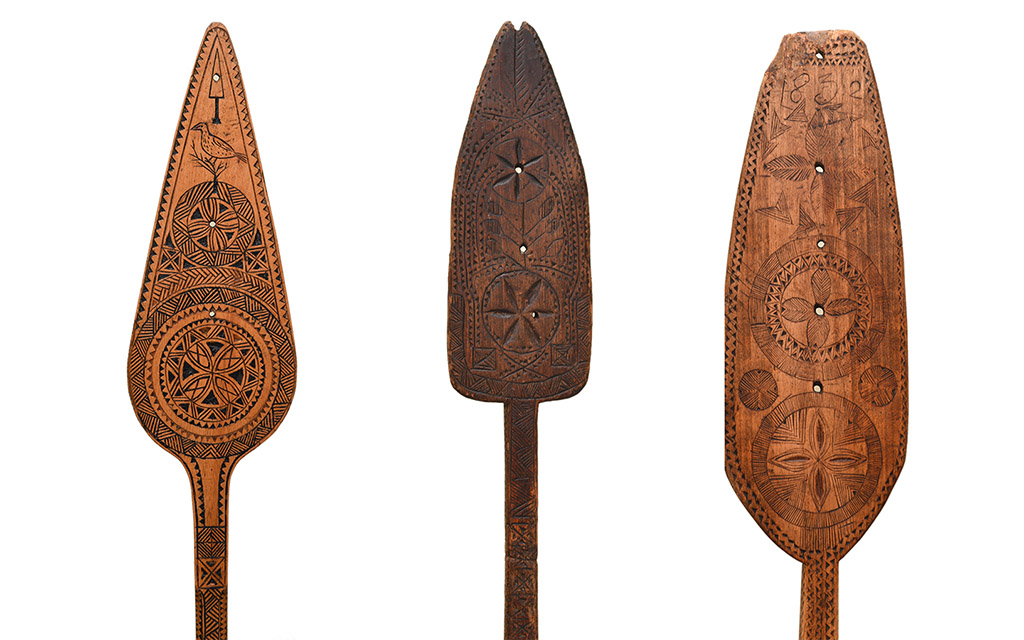
About the project ENI-LLB-1-244 “Promotion of historical and culture cross border through museums innovations” / Museum 2020
The project aims to build a cross border cooperation platform creating preconditions for ensuring the increasing interest of tourists and visitors about the cultural and historical heritage in the border area of Latvia, Lithuania and Belarus.
This project is funded by the European Union
Project budget: 367 864.64 EUR, EU funding 331 078.17 EUR
Project implementation period: 1st of June 2020 – 31st of May 2022
European Neighbourhood Instrument Cross-border Cooperation Programme Latvia-LithuaniaBelarus 2014-2020
